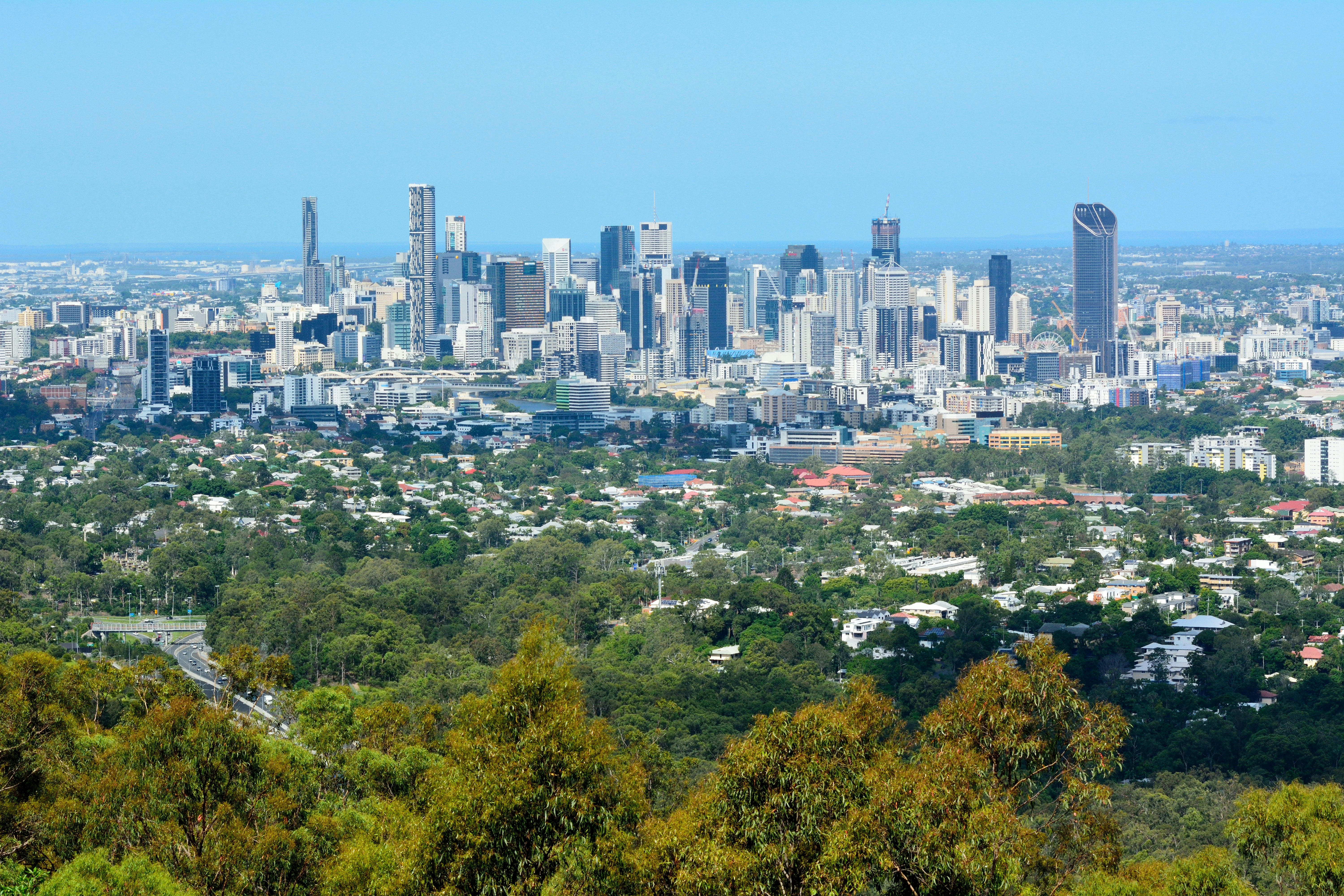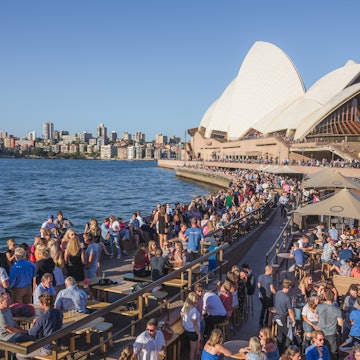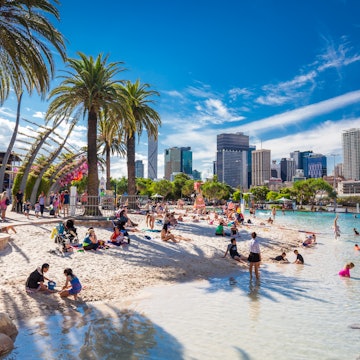
Everything you need to know about Brisbane, from etiquette to sunscreen tips

Jan 3, 2022 • 8 min read

The beach experience in Brisbane starts right in the city center © Holger Leue / Getty Images
Seductively subtropical and infectiously optimistic, Brisbane is where Queensland dreams big. Not only does it bask in 283 days of sunshine every year, it also hosts some of Australia’s hottest restaurants, bars, galleries and music venues.
Many tourists know Brissie best as the gateway to the Gold Coast and Sunshine Coast, but the city is gaining a growing following for its dining, nightlife and enviable quality of life. Before packing your shorts and shades, heed these top tips to make the most of your time in Queensland’s often underrated capital.
Planning your trip to Brisbane
There are a few must-knows before you check in for your flight to Brisbane.
Book tickets for the Airtrain online
When you land in Brisbane, the first order of business will be getting into town. From Brisbane Airport, city-bound Airtrain services depart every 15 to 30 minutes. A standard return adult fare costs A$37 (US$27) but bought online in advance, it’s considerably cheaper at A$28 (US$20). Handy stops include Central and Roma Street in the city center, party central Fortitude Valley, and the attraction-packed South Bank.
Buy a Go Card to save on transport
You don’t need a car to get around Brisbane. The city’s network of TransLink buses, ferries and trains connect all the major city sights, dining and nightlife precincts. Some routes – such as the handy No 60 bus (Blue CityGlider) – run all night on Friday and Saturday.
To save time and money, buy a rechargeable Go Card, available from station ticket machines and 7-Eleven convenience stores. Valid on all public transport, it’ll save you over 30% compared to buying paper tickets for individual rides.

Park your car prudently
If you do find yourself behind the wheel in Brisbane, steer clear of the metered street parking in the CBD (city center), which can cost as much as A$5.50 (US$4) per hour on weekdays. Metered parking in city-fringe neighborhoods such as Fortitude Valley, South Brisbane, West End and Woolloongabba costs a maximum of A$3.40 (US$2.45) per hour on weekdays, and you can easily zip into town on public transport.
If you’re really watching the pennies, try driving a few blocks off the major retail and dining strips, where quieter suburban side streets sometimes yield free, unrestricted parking. Also, check out the Visit Brisbane website for good after-work and weekend parking deals in the CBD. If you do end up using metered parking in Brisbane, it's cashless: pay via the CellOPark mobile app, or by tapping your smartphone or credit/debit card at the meter.
Know Brissie's bike rules
Bike-and-pedestrian trails such as the Brisbane Riverwalk are city highlights, but before you start pedaling, brush up on Queensland’s cycling rules. Essential rules to adhere to include wearing a helmet (exemptions are made for religious headdresses), giving way to pedestrians, and stopping at red lights and stop signs.
Simply holding a mobile (cell) phone while riding is illegal; cycling on footpaths is not. In most cases, renting a bike from Riverlife is better value than using the app-activated e-bikes scattered around the city; Riverlife will even deliver to where you are staying.
Pick a neighborhood to match your mood
Each Brisbane neighborhood has its own vibe and tribe. Party people gravitate to the "Valley" (Fortitude Valley), which is packed with hip hotels, bars, eateries, boutiques and rowdy music venues. Alternative types gravitate to the West End, which is jammed with convivial beer halls, casual eateries and one-of-a-kind book, record, vintage and indie shops.
In between the two lie the CBD (pricy for accommodation, but convenient for eating, shopping and sights) and South Brisbane, heavy on hotels, sights and tourists. Book accommodation a month or two in advance for the best choice in any of these popular hubs.
Reserve hotlist tables well ahead
On the subject of eating, reserve standout restaurants like mod-Oz Gauge, Thai-inspired Same Same, Japanese Hôntô and contemporary Chinese Happy Boy a week or two in advance, especially for weekend dining. Reservations can often be made directly through restaurant websites, or you can use the Open Table app.
If you're going all-out, reservations at nationally acclaimed Elska and Joy are released months ahead and get snapped up quickly. Joy doesn’t offer a waiting list but last-minute cancellations are announced on its Instagram stories, so follow Joy and turn on story notifications.

Plan that side trip to Straddie
If you fancy sprawling out on an idyllic ocean beach away from the city noise and hubbub, frequent car-and-passenger ferries and catamarans sail the short route between suburban Cleveland and beautiful, rugged Minjerribah on North Stradbroke Island.
Head out early for a full day of blissful beach bumming and wildlife spotting or, better still, stay a few nights at a local B&B, hotel or campground and slip into island time. Book the ferry a day or two ahead and your accommodation well in advance, especially when visiting from mid-December to late January, at Easter and during "Schoolies Week" in late November.
Etiquette in Brisbane
If it's your first time in Australia, leave your preconceptions in the arrivals hall. Here's the local etiquette you need to know to get by in Brisbane.
Be nice
By and large, Brisbanites are an affable, laidback bunch. Keep the vibe positive with a smile and friendly ‘hi’, ‘please’ and ‘thank you’ when interacting with reception and waitstaff, shopkeepers and market stallholders. If riding the buses, offer the driver a quick wave and ‘thanks’ before jumping off; it’s the norm. And while tipping is not obligatory, leaving a 10% gratuity for good service at restaurants is gracious.
Don’t leave lunch, coffee or dinner too late
While Brisbane may no longer be a 'big country town,' opening times at some eateries remain a little, well, provincial. Cafes can flip their sign from open to closed as early as 2:30pm or 3pm, leaving late lunchers and coffee snobs stranded. Specialty coffee joints with slightly longer opening hours include Campos Coffee and Blackstar Coffee Roasters. Espresso bar-cum-tattoo shop Death Before Decaf brews 24-7.
Likewise, when it comes to dinner, some restaurant kitchens close as early as 8:30pm, especially at the start of the week. Don’t blindly trust the opening times you see listed online; call ahead or dine early if you’re not keen on a late-night Macca’s (McDonald's) run.
Shout your round like a local
When locals hit a pub or bar with friends, they’ll often take turns ‘shouting’. This means buying a round of drinks for everyone in the group. If someone shouts you, shout them back; leaving just before it’s your turn is not a good look.
Brisbanites love their beer and while XXXX may be the city’s heritage brew, passionate microbreweries have revolutionized the local scene. Make time for independents such as Range, Green Beacon, Soapbox, Black Hops and Sea Legs, which brew up intriguing seasonal beers (mango sour ale, anyone?).
For a river breeze and skyline view, spend a lazy afternoon on the timber deck at Felons Brewing Co at Howard Smith Wharves, northeast of the CBD. When ordering draught, opt for a pot (285ml) or schooner (425ml) as a pint (570ml) will quickly go warm in the Queensland heat.

Cheer on a local rugby team
The NRL (National Rugby League) is a virtual religion and barracking (rooting) for a local team will get you instant kudos. Local spirits soar when Queensland’s Maroons thrash New South Wales’ Blues in the best-of-three State of Origin series.
Held in late June and early July, one of the three matches is played at Suncorp Stadium in Milton, with tickets snapped up early in the NRL season (early March to late September). If you can’t make the State of Origin, cheering on the Brisbane Broncos at any NRL game is a sure way of bonding with the locals. Home games during the winter take place at Suncorp Stadium.
What to pack for Brisbane
It isn't Aussie sunshine all the time in Brisbane. Here are some packing tips for an easy trip.
Dress lightly, but bring a jumper
Unless you enjoy that cling-wrap feeling, wear natural, breathable fabrics like cotton and linen in Brisbane, particularly during the sticky summer (coinciding with the northern hemisphere winter). Casual shorts, t-shirts and thongs (flip-flops) are fine at cafes, casual eateries and pubs, but fashionable jeans or chinos, collared shirts and lightweight jackets are better bets for evenings out at higher-end city restaurants and bars.
For women, maxi or cocktail dresses are popular out-on-the-town outfits. From May to mid-October, pack a warm jumper (sweater) for nippy nights that dip into the teens (Celsius). Some light long sleeves are also good for keeping off the sun during those 283 annual days of sunshine.
Be sun savvy
At any time of the year, don’t forget your 50+ sunscreen and sunglasses – the Queensland sun is unforgiving. Many locals wear a sunsuit or rash top on the beach, particularly kids. For daily sun-protection times and real-time UV index, download the BOM weather app.
Street smarts for Brisbane
Brissie is a safe city by international standards, but opportunistic crime exists, so keep hotel rooms and cars locked, and don't leave valuables visible through car windows. As in all major cities, avoid poorly lit areas and parks after dark.
Floods and violent storms are a fact of life in Brisbane, especially during the rainier summer months. Pay attention to warnings from local authorities during severe weather.
You may also like:
The 12 best free things to do in Brisbane
Why Brisbane is a blast at any time of year
Brisbane on a budget: the ultimate cent-saving guide












